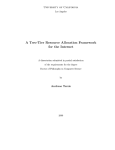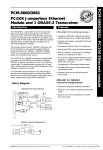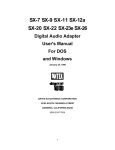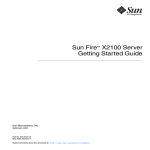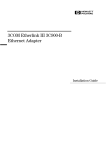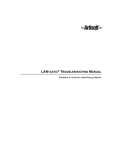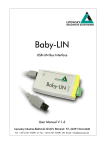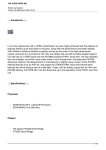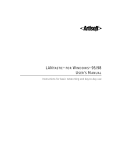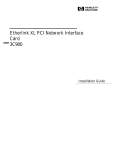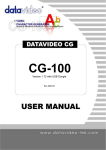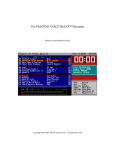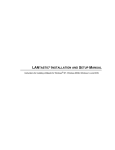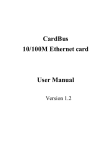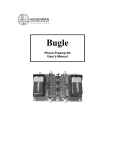Download Pristine RapidFire Manual - PM
Transcript
The All-In-One Digital Broadcast System RAPIDFIRE Table of Contents Preface Technical Support 1 2 I. Hardware Configuration 3 3 3 4 4 9 Recommended Computer Specifications Optimal Card Placement External Requirements Audio Connections Satellite Relay Connections II. Software Installation DOS Setup Pristine Software Installation III. User’s Guide The Playback Screen The Selection Section The Players The Drop Box The Playlist Management Area The Quick Pick Screens E-List or Emergency Playlist TimeWarp Execution EAS (Emergency Alert System) RapidFire Autobreaks & Liners RapidFire Quick Keys RapidFire Time Update RapidFire Time Synchronization RapidFire Audio File Compatibility RapidFire “Filler” Files (for missing playlist items) RapidFire Time Announcements RapidFire “Shrink /Stretch” Playback Feature 10 10 10 13 13 14 16 22 24 32 36 37 38 40 41 41 41 42 43 44 45 Preface Thank you for selecting Pristine RapidFire as your digital studio system. By listening to our thousands of users over the past decade, Pristine has developed RapidFire, the most powerful Digital Studio System in the industry. While other companies come and go, Pristine Systems’ commitment since 1988 to the entertainment and radio industry is proven by its’ growing list of hundreds of satisfied customers worldwide. RapidFire continues Pristine’s tradition of offering the best integrated music scheduling, production and on-air systems in the industry. So blow away your competition with the exiting new Pristine RapidFire! About this manual This manual is divided into three main sections: I. Hardware Configuration This section of the manual explains hardware configurations and setup information necessary for your system to perform optimally. II. Software Installation This section of the manual will walk you through installing your RapidFire software. III. User’s Guide This section of the manual will familiarize you with the many rich functions of RapidFire. Technical Support Our friendly knowledgeable technical support representatives are always glad to help out with any difficulties you may be having with the system. Technical support can be reached in a variety of ways. 1. Fax (310) 670-0133 To obtain technical support via Fax, an “INFO-PRT,” which is explained in the following paragraph, should be faxed with a detailed description of the problem encountered. The Fax should also include how to reach you by voice, e-mail, and fax. An INFO-PRT is a print out of your system’s settings and memory that will help our technical support representatives in trouble-shooting any problems. To generate an “INFO-PRT,” simply go to the computer you are having difficulties with, get to a DOS prompt that resembles the following C:\MUSICMGR> or C:\MUSICPLS>.. Then get a formatted diskette and place it into the A: Drive. Once the diskette is secured, type the following command at the prompt: INFO-CPY. Follow the on-screen instructions and an “INFO-PRT” should be generated and faxed to us at the above number. 2. E-mail [email protected] Pristine Systems technical support over the internet via E-mail is one of the fastest technical support resources at Pristine. The reason that technical support via E-mail is quicker than any other service is that it provides the use of file attachments over the internet, thus facilitating the sending and receiving of program and database files. Simply write an E-mail detailing the problem you are experiencing, attach a “psi-zip” of your databases, and send it to the above E-mail address. An E-mail will then be reviewed by one of our resourceful technical support representatives and a solution will be promptly E-mailed back to you. 3. Phone Direct (310) 670-7500 When calling direct to Pristine Systems, make note of any changes that had occurred prior to the problem. Make notes as to the specific error encountered. Technical representatives are available Monday thru Friday from 8:00am - 5:30pm Pacific Time Zone. 24 Hour Voice Mail is checked periodically. 2 I. Hardware Configuration Recommended Computer Specifications For Hard Disk only Systems: Pentium II 300 or better 8 Slot Motherboard (3 ISA 4 PCI 1 AGP) Minimum 32MB of RAM MS-DOS 6.22 17” SVGA Color Monitor 2.0 GB or larger internal hard disk drive and/or external drives (depending on size of library, this number varies; 2MB per stereo minute storage) 1.44MB floppy drive Trackball or Mouse 1 Dual Device 32k or 48k Professional Digital Audio Playback Card 1 Dual Device 32k or 48k Professional Digital Audio Production Card For Hard Disk and Satellite: Same configuration as above plus the following, 1 1 1 1 Metrabyte I/O Card STA-U I/O Box ERB Relay Board Stereo Switcher Optimal Card Placement (inside computer) For 2 Audio Card Setup: ISA Slot 1 ISA Slot 2 ISA Slot 3 PCI Slot 4 PCI Slot 3 PCI Slot 2 PCI Slot 1 Audio Card #1 Recording/Playback Card Audio Card #2 Playback Only Card Metrabyte Card (only for satellite systems) SCSI Controller Card (only when using SCSI drives) Network Card VGA Display Adapter Card (or AGP slot) 3 For 3 Audio Card Setup: ISA Slot 1 ISA Slot 2 ISA Slot 3 ISA Slot 4 PCI Slot 4 PCI Slot 3 PCI Slot 2 PCI Slot 1 Audio Card #1 Recording/Playback Card Audio Card #2 Playback Card Audio Card #3 Playback Card Metrabyte Card (only for satellite systems) SCSI Controller Card (only when using SCSI drives) Network Card VGA Display Adapter Card (or AGP slot) External Requirements 1. RapidFire Dongle must be attached to LPT1 port or the printer port of the on-air computer. 2. Mouse, Trackball, or Touchscreen Interface must be connected to COM1. 3. General I/O (input/output) devices, such as monitor and keyboard and SCSI Drive connections should also be made. Audio Connections ADAPTER INSTALLATION Make sure the main power to your computer is OFF. You will need a full-size, 16 bit/AT slot. If you are unfamiliar with the internal design of your computer see its "Guide to Operations" manual for step by step installation procedures. Read JUMPER SETTINGS and CONNECTIONS for information about configuring the adapter before plugging it into the slot. JUMPER SETTINGS The Antex SX series audio adapters have several hardware jumpers which are used for multiple board operation. Refer to the Antex User’s Manual for your particular Audio Card for the proper jumper settings. NOTE: On the SX-7, jumper JP2 serves as the adapter selection jumper. Adapter 1 is at the top, with adapter 4 at the bottom. 1 2 3 4 PLACE JUMPER HERE IF YOU HAVE ONLY ONE ADAPTER 4 Connections SX-7 There are four external connectors located on the SX-7 audio board's metal mounting bracket. See Figure 4. There is also one three pin header (JP1) for an optional user-supplied headphone connection, which would allow for a front panel headphone jack. LEFT 1 RIGHT GND JP1 DB-9 Balanced Out SX-7 Headphones Unbalanced Right Unbalanced Left Balanced Analog I /O Connector 5 4 3 2 1 DB-9 Female Pin 1 2 3 4 5 6 7 8 9 Assignment Gnd nc nc Right Out Left Out nc nc Right Out + Left Out + 9 8 7 6 Figure 4: SX-7 Connector Locations Audio Output: Line: Unbalanced - RCA jacks, 2VRMS/+6dBV max (digital clipping), with an impedance of 470 ohms and a load impedance of > 10 k ohms Balanced - Nine pin D connector, -16 dBm maximum, with an impedance of 47 ohms and a load impedance of 600 ohms Headphone: 1/4" Stereo Phone Jack, 0.5 VRMS into eight ohms NOTE: We recommend using the balanced Analog I/O for professional broadcast applications 5 SX-9 There are 5 connectors located on the SX-9 audio board's metal mounting bracket. See Figure 5. Audio Output: Line: Balanced - Nine pin D connector 0 to +26dBu(digital clipping) - software selectable with 1dBu resolution, with an impedance of 50 ohms and a load impedance of 600 ohms Unbalanced - 1/8” stereo mini jack 2VRMS/+6dBV max (digital clipping), with an impedance of 470 ohms and a load impedance of 10k ohms Unbalanced - 1/8” stereo mini jack 2VRMS/+6dBV max (digital clipping), with an impedance of 470 ohms and a load impedance of 10k ohms LEFT 1 RIGHT GND JP1 DB-9 Balanced Out SX-9 Stereo Mini Headphones Unbalanced Right Unbalanced Left AES/EBU, S/PDIF Digital Out Pin 1 2 3 4 5 6 7 8 9 Balanced Analog I /O Connector 5 4 3 2 1 DB-9 Female 9 8 7 6 7 pin Mini DIN Female 7 6 5 3 4 2 1 Pin 1 2 3 4 5 6 7 Assignment Gnd nc nc Right Out Left Out nc nc Right Out + Left Out + Assignment Ground nc Out - AES/EBU+ or S/PDIF+ nc Out - AES/EBU - or S/PDIFnc AES/SPDIF sense - This line should be connected to Ground for AES/EBU operation and left floating for S/PDIF Figure 5: SX-9 Connector Locations AES/EBU Digital: 7 pin Mini DIN jack. Professional AES/EBU: EIAJ CP-340 Type I / IEC-958 Pro or Consumer S/PDIF: EIAJ CP-340 Type II / IEC-958 Consumer NOTE: We recommend using the balanced Analog I/O for professional broadcast applications 6 SX-23e There are 7 external connectors on the SX-23e. See Figure 6. Audio Input: Line: Balanced - Nine pin D connector 0 to +26dBu (digital clipping) - software selectable with 1dBu resolution, with an impedance of 20k ohms Unbalanced - 1/8” stereo mini jack 2VRMS/+6dBV max (digital clipping), with an impedance of 20k ohms and a load impedance of 10k ohms AES/EBU Digital: 7 pin Mini DIN jack. Professional AES/EBU: EIAJ CP-340 Type I / IEC-958 Pro or Consumer S/PDIF: EIAJ CP-340 Type II / IEC-958 Consumer Audio Output Line: Balanced - Nine pin D connector 0 to +26dBu(digital clipping) - software selectable with an impedance of 50 ohms and a load impedance of 600 ohms or greater. Unbalanced - 1/8” stereo mini jack 2VRMS/+6dBV max (digital clipping), with an impedance of 470 ohms and a load impedance of 10k ohms Headphone : 1/4" stereo phone jack, 0.5 VRMS into 600 ohms or greater. AES/EBU Digital: 7 pin Mini DIN jack. Professional AES/EBU: EIAJ CP-340 Type I / IEC-958 Pro or Consumer S/PDIF: EIAJ CP-340 Type II / IEC-958 Consumer Adapter # jumper block Balanced Analog Header SX-23e Balanced I/O Unbalanced In Unbalanced Out Headphones Digital AES/EBU I/O Digital Header Figure 6: SX- 23e Connector Locations 7 Balanced Analog I /O Connector 5 4 3 2 1 DB-9 Female 9 8 7 6 Ground Right In + Right In Left In + Left In Right Out + Right Out - Pin 1 2 3 4 5 6 7 8 9 Assignment Ground Right In Left InRight Out Left Out Right In + Left In + Right Out + Left Out + Left Out + Left Out - Balanced Analog Header 2 4 6 8 10 12 14 16 1 3 5 7 9 11 13 15 7 pin Mini DIN Female 7 6 5 3 4 2 1 Pin 1 3 5 7 9 11 13 15 Pin 1 2 3 4 5 6 7 Assignment Right In + Right In Left In + Left InRight Out + Right Out Left Out + Left Out - Pin 2 4 6 8 10 12 14 16 Assignment Ground Ground Ground Ground Ground Ground Ground Ground Assignment Ground In - AES/EBU Out - AES/EBU+ or S/PDIF+ In - AES/EBU + Out - AES/EBU - or S/PDIFIn - S/PDIF+ AES/SPDIF sense - This line should be connected to Ground for AES/EBU operation and left floating for S/PDIF Figure 7: SX- 23e Balanced and Digital Connectors NOTE: We recommend using the balanced Analog I/O for professional broadcast applications 8 Satellite Relay Connections Pre-made Metrabyte shielded cables should connect from the back of a Metrabyte PIO-12/24 card (which is inside the computer) to the STA-U (Blue Box), and then from the STA-U to the Relay Board. Then the wiring should go as follows: The STA-U acts as an input/output interface. The following Pin Assignments are used by RapidFire. A contact closure from Pin 18 to the Pins listed below will result in the function described next to the Pin #. Pin # Function 18 +5 Volts 30 “AUTO” Mode 31 Liner 1 32 Liner 2 33 Liner 3 34 Time Sync (refer to the rapid.ini) 35 “LIVE” Mode 36 Relay Recording Notification (TimeWarp!) 37 EAS (refer to page 38 in this manual) 32+33 Liner 4 31+33 Liner 5 31+32 Liner 6 9 II. Software Installation Step 1 DOS Setup Make sure that DOS is installed and that the system is correctly booting off the first hard drive. If DOS is not on the computer system, then it must be installed. To install DOS, consult your MS-DOS user’s guide. Step 2 Pristine Software Installation Place the first diskette labeled Pristine RapidFire into Drive A:. Then type in the following: A:RF-SETUP (Enter) Then follow the on-screen instructions to finish the installation. After the files have been installed from the diskettes, the autoexec.bat must be edited to include the following statement: CD \RAPID CALL PLAY The following is an example of what a typical RapidFire autoexec.bat should look like: @ECHO OFF PROMPT $p$g PATH C:\;C:\DOS;C:\LANTASTI;C:\CTRL;c:\RAPID SET TEMP=C:\DOS LH C:\DOS\SMARTDRV.EXE 2048 /X call C:\LANTASTI\STARTNET.BAT CD \RAPID CALL PLAY The following is what a typical RapidFire config.sys should look like: DEVICE=C:\DOS\HIMEM.SYS DEVICE=C:\DOS\EMM386.EXE NOEMS DOS=HIGH,UMB FILES=60 BUFFERS=30 LASTDRIVE=Z DEVICEHIGH=C:\LANTASTI\PROTMAN.DOS /I:C:\LANTASTI DEVICEHIGH=C:\LANTASTI\EL90X.DOS 10 The following is what a typical RapidFire play.bat should look like: C:\AUDIODRV\SX25 /U C:\MOUSE\MSCMOUSE /A4 /1 C:\AUDIODRV\SX25 /B32 /B32 /B32 /B32 RAPID C:\AUDIODRV\SX25 /U C:\MOUSE\MSCMOUSE /U (OR SX-34 DRIVER) (OR SX-34 DRIVER) (OR SX-34 DRIVER) The rapid.ini file and settings: AudioBaseAddressCard1 AudioInterruptCard1 = 1 iIOAdd1 1 = 180 2 = 280 3 = 380 = 3 iInter1 AudioBaseAddressCard2 AudioInterruptCard2 = 0 iInter3 AudioSampleRate = 1 iSR1 = 1 iTWFormat AudioChannels 4 = 220 5 = 300 6 = 320 2,3,4,5,10,11,12 = 0 iIOAdd3 1 = 180 2 = 280 3 = 380 AudioInterruptCard3 AudioFormat 2,3,4,5,10,11,12 = 2 iIOAdd2 1 = 180 2 = 280 3 = 380 = 5 iInter2 AudioBaseAddressCard3 4 = 220 5 = 300 6 = 320 0 = No Card 4 = 220 5 = 300 6 = 320 0,2,3,4,5,10,11,12 1 = 48000 2 = 44100 3 = 32000 1 = MPEG 2 = DOLBY-AC2 = 2 iNoChannels 1 = MONO 2 = STEREO AutoBreakMinutesDefault = 59 iABreaksMM AutoBreakSecondsDefault = 00 iABreaksSS AutoBreakTypeDefault = A cABreaksTp A = -GO-END 11 AutoStartMode MetrabyteBaseAddress MetrabyteCardType = 1 iAutoStartMode B = -GO-TOP NO FADE C = -GO-TOP WITH FADE 0 = LIVE MODE 1 = AUTO MODE = 3 iMetraPort 0 = NO CARD 1 = 310 2 = 320 3 = 330 = 0 iMetraCard 0 = NO CARD 1 = PIO-24 2 = PIO-96 MetrabyteSignalDuration = 3 iMetraSigD (0 - 10) Satellite Liners123 = 0 iSLiners123 0 = OFF 1 = ON Satellite Liners456 = 0 iSLiners456 0 = OFF 1 = ON TimeWarpActive = 0 iTWActive VolumeOutputDefaultPlayer1 = 10 VolumeInputDefaultPlayer1 = 10 VolumeFadeDefaultPlayer1 = 6 VolumeOutputDefaultPlayer2 = 10 VolumeInputDefaultPlayer2 = 10 VolumeFadeDefaultPlayer2 = 6 0 = OFF 1 = ON iVolOutput[0] (0-10) iVolInput[0] (0-10) iFadeStep[0] (0-10) iVolOutput[1] (0-10) iVolInput[1] (0-10) iFadeStep[1] (0-10) VolumeOutputDefaultPlayer3 = 10 iVolOutput[2] (0-10) VolumeInputDefaultPlayer3 = 10 iVolInput[2] (0-10) VolumeFadeDefaultPlayer3 = 6 iFadeStep[2] (0-10) VolumeOutputDefaultPlayer4 = 10 iVolOutput[3] (0-10) VolumeInputDefaultPlayer4 = 10 iVolInput[3] (0-10) VolumeFadeDefaultPlayer4 = 6 iFadeStep[3] (0-10) SyncTimeToExternalSource = 0 SyncTimeMinutes =0 SyncTimeSeconds =0 iON=1 OFF=0 iSyncTimeMinutes 0-59 iSyncTimeSeconds 0-59 DaylightSavingsOption DaylightSpringMonth DaylightSpringDay DaylightFallMonth DaylightFallDay iON=1 OFF=0 =0 =4 =4 =10 =31 12 III. User’s Guide The Playback Screen The Playback Screen is divided into four color-coded sections: The Players (Green), The Drop Box (Yellow), The Selection Section (Blue), and The Playlist Management Area (Purple). The Players The Selection Section The Playlist Management Area The Drop Box 13 The Selection Section What is it? Designates live mode. When activated, the button will switch to designating auto mode or “walk-away” mode. In live mode, the Jock is responsible for cueing up and playing items manually within the virtual player environment, when in “walk-away” mode, the computer is responsible for playing the playlist as scheduled. You can also think of the Live as Pause Mode since the system will stop playing after the current event stops. This is an ideal way for a jock to do live reads. The jock simply start the system back up when he changes the mode back to Auto Mode and the system starts to play again. , , , , , , and icons will bring you into The The Quick Pick Screens when activated. Each button will activate the corresponding Quick Pick Screen according to their headings. The icon allows for additional function icons. The Login icon to update any information found in the Drop Box. allows you How do I use it? To get into Live Mode or Pause Mode 14 The program starts out in the default as Live Mode . When the mode has been changed to Auto Mode , and you want to change it back to Live Mode that it displays , simply click on the icon once, so . To get into Auto Mode Since the program starts out in the default as Live Mode click on the icon to change to Auto Mode , to change it to Auto Mode , simply . To update Drop Box Data From time to time, new drops are created and need to be implemented to add flair to a jock’s program. In order to keep up to date with new drops that have been created in the Drops Data section, simply click on the Login Icon to refresh the Drop Box with new changes. 15 The Players What is it? The players are arranged and will be referred to in this documentation in the following order: Player 1 Player 2 Player 3 Player 4 Each player represents an individual virtual cart machine which can be loaded and played just like a physical cart machine. Display Area Audio Level Meters Player Controls Item Info Level Controls Display Area - shows the current item loaded into the player and its status. Status of the item is displayed in the color of the item: If the item is.... Green Red Yellow White the item is loaded and ready the item is playing the item is in pause the item has already been initiated and stopped 16 Audio Level Meters - displays the audio level in db’s of an item while playing. The blue represents audio levels below “0”, the yellow represents “safe” audio levels below “0”, and red represents an overload level. Item Info - displays the intro. time, actual time remaining, and fade time of the item: The intro time will count down to “0” so the jock will know where the intro post is. The true time of the audio file will appear when the event is loaded. It will count down to zero for the time remaining, note: at 30 seconds left it will turn RED. The fade time will count down to zero. In Auto Mode it will start the next event at the fade time of the current event. Level Controls - allow you to control output, input, and fade levels. The levels range from “0-10” with “0” designating no level input or output. With relation to fade level, “0” sets the manual fade to none or sudden fade out, whereas “10” represents the maximum fade out time. The levels are changed by clicking on the arrows to the left and right of the level display. The right arrow lowers the level and the right arrow raises the level. Player Controls - Each player has two different modes of action: Ready Mode and Play Mode. Ready Mode The buttons on the virtual cart machine work as follows in “ready mode”: Eject Play Load Auto-Load Clear - removes anything loaded and resets the player. Play - plays the item loaded in the player and brings the player into Play Mode. Load - allows you to manually load an item from the playlist section. Simply click on display into the player. and the player will , then go to the playlist section and click on the item you want to load Auto-Load will automatically load the next item in the playlist. Continuously hitting this button will cycle sequentially through the items in the playlist. 17 Play Mode The buttons on the virtual cart machine work as follows in “play mode”: Stop Play Pause Fade Stop - will stop the item currently active in the player and go back into Ready Mode. Play - will resume play of an item in pause. Pause - will pause an item in play. Fade - will initiate a manual fade on an active item in the player. How can I use it? Manually loading a player with a song from the playlist of the designated player, then click on an item in the To manually load a player simply click on the playlist. The item will then be placed in the player. example: If I wanted to play Total Eclipse of the Heart, I would click on the of the player, then the message would appear inside the player window. I would then click on the song title from the playlist, and it would appear in the window to replace the message. Then I could simply hit play to play the item. Automatically loading a song from the playlist To automatically load a song from the playlist, simply click on the playlist que will be loaded. of the player. The first item in the example: If I wanted to automatically load the first item in the playlist, Sussudio by Phil Collins, I would simply click on the and it would automatically be loaded into the player. The next item to be automatically loaded would then be Total Eclipse of the Heart , since it appears next in the playlist. 18 Loading an item from the Quick Pick Screens , , , , , , and icons will bring you into The The Quick Pick Screens when activated. Each button will activate the corresponding Quick Pick Screen according to their headings. Once in a quick pick screen, simply click on the load control of the player you wish to load the item into, then click on the item you wish to load, and it should appear in the player display. example: If I wanted to load a player with the song __________, then I would fist click on the music icon in the selection section Then click on the load of the player and the song should be loaded. Click on here to bring up the music listings. This button brings you to the Music Quick Pick Screen. 19 Click first to put the player in load mode. Then Click here to load this song. Ending a Hard Disk Audio Item There are three ways to end the play of a Hard Disk Audio Item. One way is to simply let it finish playing. The second ways to stop it manually, and the third way is to fade out of it. To stop it manually, simply click on the stop button of the player which the item is playing on. To fade out of an item, I would first set my fade adjustments to 5 if I were using a Pentium 133. To set the fade level, click on the arrow to the left of level display of the player which is about to fade. Then click on the fade button and the song should fade out according to the fade level set. The level number set indicates how tight a fade is. The lower the number, the tighter the fade, thus the higher the number, the longer the fade. example: I want a tight fade out of a song. I would set my fade level to 2 by clicking on the right arrow of the fade level . Then I would simply hit the fade button. adjuster Fade Button 20 Clearing out a player To clear out a player will get the player back to “ground zero.” If a song is playing or active, the player controls will look like this . First you must stop the song by hitting the left most button or the stop button. Then the player controls will become like this . From this point to clear out the program, simply click on the left most button again and this should clear out the player. example: I want to clear out an event that is playing currently. I would first click on the button shown here on the particular player: This is the Stop Button. Click here to stop song. Then the player control buttons should change to button. , and I would simply click on the left most This is the clear or eject button. Click here to clear song 21 The Drop Box Drop Group Selection Player Selection Drop Buttons What is it? The Drop Box is basically an “instant-play” tool. It holds 90 drops per jock for 12 jocks. Any type of hard disk audio may be stored in the Drop Box, from songs and intros, to sound effects and even commercials. The Drop Box is an easy and fun to use tool for the live jock that needs instant playing power. Drop Buttons - activate a button and the drop listed will play instantly. If more than one drop is activated, they will play in the order that the drop was selected. Drop Group Selection - changes the available drops currently on the screen. Continuous hitting of the button will cause the buttons to cycle through 5 different groups of drops: Groups A-E. Player Selection - changes the drop playing arrangement to incorporate two players or one player (default). By allowing two players to be active, two drops can be made to overlap each other with sequential drops to be played after them with the first available player. How do I use it? Playing One Drop Make sure that the player selection area displays P4. This means that only one drop player is activated. Simply activate any of the Drop Buttons to instantly play the drop listed. example: If I wanted to play Laser EFX, then I would click on the box and it would play. 22 Playing Multiple Drops One After Another First, the player selection area must display P4, as stated above, this setting allows for only one player to be allotted for drop playing. If more than one drop is then selected, the drops will play in the order that they were selected in. example: If I wanted Laser EFX to play first , followed by a Bomb Blast, then I would simply click on the Laser EFX box and then click on the box labeled Bomb Blast, what would happen is that the Laser EFX will play instantly followed by the Bomb Blast. Overlapping Multiple Drops. However, if P3 & P4 were displayed in the Player Selection area, then multiple drops would play simultaneously. example: If I wanted to play a Sports Opener with Laser EFX at the same time, I would click on the Player Selection Area to display P3 & P4. Then I would click on the box labeled Sports Opener, and then Click on the Laser EFX box when I wanted the effect to play. Editing the contents of the Drop Boxes Refer to Rapid Drop Box Editor-Walkthrough when editing Drop Box Items. 23 The Playlist Management Area Info Display Reset Home Editing Tool Bar Playlist Display Home Scroller What is it? Info Display - displays current time and date. With future enhancements, it will display temperature and other various pertinent information. Playlist Display - displays the playlist as follows: time scheduled to play Intro. time Title Artist Fade time Actual time Scroller - The arrows at the top and bottom of the scroller let you advance one item up or down on the playlist, area will allow you to advance a whole page up and the while the page down. Home - area will allow you to advance a whole brings the item “next up” to the top of the Playlist Display Reset Home - designates what is “next up” on the play list. Click on playlist that you want to play next. and then click on the item in the 24 Editing Tool Bar - has two different modes: Current Hour and Extra Hours. In the Current Hour mode, the tool bar is as seen above. The buttons are as follows: is used to get to “ground zero”. The button clears any commands that the program has in memory. Whenever you lose your bearings this icon is a safety feature to get you back to start. If you click on the right mouse button, it will activate the clear icon automatically. is used to move items in the playlist to a new location in the playlist. Simply click on the icon and then click on the item of the playlist you wish to move, then click on the item in the playlist you want to place the moved item to. works in the same manner as the except that the first item activated by the swap will switch places in the playlist with the second item activated. Simply click on the icon, then click on the items to be swapped, one after another. will delete items from your playlist. As a precaution, hit the clear button when finished deleting playlist items to remove the command from program memory. allows you to insert music, spots, promos, psa’s, etc... Click on the icon, choose an option from The Selection Section, find the appropriate item to insert and then click on the location of the playlist you wish to put it. toggles between current hour and other hours editing modes Other hours editing mode; the tool bar changes to the following display The buttons remain the same in functionality, except for there is no home or reset home buttons. They have been replaced with an hour advancer through the hours accordingly. and an hour decreaser buttons, which allow you to cycle 25 As you may have noticed, the edit button hours editing mode. has been replaced with an so that you may exit the extra How do I use it? The Playlist Management Area helps you manage the playlist with status checking and playlist manipulation. You may edit the hour that is currently playing or any other hour of the day. All editing is done with simple point and click operation. Bringing the active event (the event set to play next) in the current hour playlist to the top of the list After scrolling through the playlist, often people lose their place and wonder what is going to play next. With the home option Playlist Display. the item which is going to play next will automatically be updated to the top of the example: If I was scrolling up and down to see the upcoming items in the playlist, and had lost my place, I would simply and the Playlist Display area would automatically update the next item in the click on the home icon playlist to the top of the display. Resetting the active event in the current playlist hour The reset command is the same as telling the playlist where to begin in the playlist. To use the option, simply click on the icon load command command and then click on which song you would like to set as the next event. The auto- in each of the players would now be pointed to the new item selected by the reset . example: If I wanted to go to the sixth event on the playlist rather than start playing it from the top. I would click on the reset home icon and then click on to the sixth event. The item is now designated as the first event to play 26 next in Auto-Load or Auto Mode. To double check, just click on the home icon should be highlighted in blue and at the top of the playlist display. and the sixth event Inserting a audio event in current hour playlist In order to add new events to the playlist while on the air, they must be inserted using the insert icon First you must click on the icon . , then you must decide what it is you would like to add. The choices for addition are found on the Selection Section Area. From the Selection Section, you can choose either , , , , , , and icons. From there, they will bring you into The Quick Pick Screens when activated. Each button will activate the corresponding Quick Pick Screen according to their headings. When in the appropriate Quick Pick Screen, you may choose an event to be inserted. After a choice has been made, simply click on Insert again at the bottom of the screen and then place the event in the playlist. To place the even in the playlist, click on the event already in the playlist that you wish to place the new event ahead of. example: If I wanted to add Toto by Africa to my current hour playlist, I would select the insert icon would select the Music Quick Pick icon . Then I . Then I would do the following: 27 Click here to choose this item. Then click here to insert the event into the playlist. Then I would finally choose a place in the playlist to add the event and simply click on the area. Moving a audio event within the current hour playlist Depending on the mood of the jock at the time, a playlist may be altered by moving events from one place in the playlist to another. This can be achieved quick and easy with the move icon . Simply click on the move icon then click on the event you wish to move, and then click on the location where you want to place the event. The playlist will update immediately with your changes. example: If I wanted to move the song Danger Zone to be the first song in the three song lineup it was currently in, I would use the move function. I would first click on the move icon , and then click on the song Danger 28 Zone, and then click on the song The Stroke, since I want to move Danger Zone ahead of this song. Here is an illustrated example: I would first click here to enable the move function. Next I would click here to choose the song I would like to move. Finally I would click here, because this is the location that I would like the song to be moved to. The result of the move function should display Danger Zone first in the set, followed by The Stroke and finally with Margaritaville finishing the three song set. Swapping two audio event within the current hour playlist If I wanted to switch the position of the two songs rather than just place one ahead of the other, the swap icon would be implemented rather than the move . The swap simply replaces one item with the other. The steps remain the same as the previous example, except for the first step being that you must choose the swap icon rather than the move icon . The result would list the songs as Danger Zone being first, with The Stroke playing last in the set. Simply click on the right button of the mouse to clear the function or click on the icon marked clear . Deleting a audio event within the current hour playlist Sometimes audio events that are not desired to play enter the playlist, this is why the delete function created. By using the delete icon was , unwanted playlist items can be removed painlessly. example: 29 If I wanted to remove Pristine Promo 4 from the playlist, I would simply go to the delete icon and click on it, then go to Pristine Promo 4 in the playlist and click on that. Then I would click on clear to stop myself from deleting any other items from the playlist by accident. Click here first to enable the delete function. Then click here to delete this item from the playlist. Editing the other hours of the day In editing other hours of the day, you would use the same functions as stated above except for the reset home and home functions. The only difference is that you would be editing hours that have not played yet. To begin . When the edit icon is activated, the Playlist Display editing these hours simply click on the edit icon will automatically bring up the next hour in the playlist and a slightly modified the tool bar which looks like the following: The buttons remain the same in functionality, except for there is no home or reset home buttons. They have been replaced with an hour advancer and an hour decreaser through the hours accordingly. As you may have noticed, the edit button buttons, which allow you to cycle has been replaced with an 30 so that you may exit the extra hours editing mode. Otherwise all other editing functions still remain the same as described prior to this section. 31 The Quick Pick Screens Time Display Players’ Status Quick Pick Items Indexer Players’ Controls Quick Pick Tool Bar What is it? Players’ Status Player 1 Player 3 Player 2 Player 4 32 The colors of the items in the player status displays denote the status of the item in the display. The colors correspond to the status in the same manner as in the Playback Screen: Green Red Yellow White the item is loaded and ready the item is playing the item is in pause the item has already been initiated and stopped Quick Pick Items display the available items within the section selected from the Selection Section. The Indexer helps you find available items quickly by jumping to the items which contain the corresponding first letter. The Quick Pick Tool Bar helps you navigate through the quick pick screens by letting you choose to view the items either by title, artist, category, or time. It also includes an insert function and the ability to control live and auto modes of playback. as found in the selection section. The Player Controls is one of the most unique options that RapidFire has to offer. Total control over all four players are still maintained within the quick pick screens. From these controls within the quick pick screens, you are able to stop, load, play, or auto-load an item into any of the four players. The stop command simply stops the player from playing an item currently in progress. The load command loads an item off of the quick pick screen that you choose. The play simply plays the currently loaded item in the playlist. The auto-load command will automatically load the next designated item in the playlist for the day from the Play Back Screen. How do I use it? Searching for events To search for a desired event simply use the page up and page down icons to scroll through the items until the desired event is seen on the screen. example: If I wanted to find an event that was not currently on the initial screen I would use the page down icon and simply scroll down the pages until the item I wanted appeared. Finding items quicker with the Indexer 33 With the same scenario in mind as above, instead of paging down with the page down icon, I would simply select the letter that my event begins with and the pages would automatically update to the one that begins with the letter I have selected. Loading a player directly To load an item directly into a player from the quick pick screen, simply go to the top right corner of the screen and choose the load function on the player you wish to load with an item. Then simply click on the item you wish to load and it should appear in the player status area. example: Click here first to select the load function on this player. Then click here to select this item to load in the player you have chosen. Inserting an event to the playlist To insert an event to the playlist, simply click on insert, then click on the event you wish to insert into the playlist and the screen will change to the playback screen. Simply go to the location of the playlist you wish to 34 insert the event into and it will appear there. 35 E-List or Emergency Playlist What is it? This E-List or Emergency Playlist is a playlist that will play if a current hour or days’ playlist are not found. The system automatically loads the E-List’s playlist. How do I use it? Simply copy a days playlist to the E-List extension. This will create an Emergency Playlist for those unexpected times of need. Dos Commands that are necessary to create an E-List: copy jan17.0* e-list.0* In the place of jan17, you would place the date of the playlist you wish to copy into the emergency playlist. Helpful Hint: Place unique station liners in the emergency playlist is that the station personnel would recognize that the correct playlist is not currently airing. When the correct playlist is transferred to the On-Air machine, RapidFire will automatically switch to the proper playlist. 36 TimeWarp Execution RapidFire is able to process TimeWarp logs that will allow you to record certain programs while on the air. Simply process your TimeWarp.dat file using the TimeWarp software and RapidFire will record your programmed events as scheduled. Refer to Pristine TimeWarp manual on detailed instructions on how to define and schedule events for timeshift recordings through RapidFire. TimeWarp recording within RapidFire Player 4 is used as a recording device within RapidFire. Events are recorded into the C:\SPC directory of the on-air machine. RapidFire converts a four digit SP#### from TimeWarp into a Five digit SP9#### by adding a leading 9. TimeWarp records either using time definitions or tone notification. Time definitions are defined through TimeWarp and cause RapidFire to record events based on time. Tone notification causes RapidFire to wait for a contact closure to Pin 36 on the STA-U (Blue Box) to start recording an event, it also relies on a contact closure to Pin 36 again to stop the recording of the event. Wiring the Satellite connections should be made according to the setup of RapidFire earlier noted in this documentation. 37 EAS (Emergency Alert System) What is it? The FCC has required that all stations must include EAS devices in the event that the government needs to make public announcements. RapidFire is programmed to handle and interact with Burk Technology’s EAS Device through the existing satellite hardware(PIO-12, STA-U, ERB-24). The system works in the following manner: When the EAS device receives a signal, it will automatically record the message. Then it will alert RapidFire that the device has a message to play. RapidFire will let current event finish playing, then signal to play a prerecorded opener, then it will play the device’s message, then play a pre-recorded closer, and finally resume the current playlist. How do I use it? To begin implementation of the system, make sure all hardware connections are made. Pin 37 of the STA-U should be used as the contact closer to alert RapidFire that the EAS device has a message to play. Relay 23 on the ERB-24 is the relay output that should be connected to the EAS device to actually play the message. To pre-record the opener and closer for an EAS broadcast, simply record two hard disk audio events labeled as SP99998.SPC as the opener and SP99999.SPC as the closer. 38 The Sage features three programmable relays: 1. Attention Active 2. Encoder Active 3, Decoder Active The Sage Endec Connections to the Metrabyte Setup are as follows: Decoder Active & Attention Active or Encoder Active should be connected to Pin 37 on the STA-U (Blue Box) Note: Depending on which ones are programmed for EAS Alert and End of Message tones, the two should be connected to Pin 37. Default Setup has Decoder Active set to EAS Alert, so you would only have to program one of the other relays. These relays contain a +5 volts. Manual Override should be connected to Relay 23 on the ERB-24 (Relay Board). Note: A +5 volt needs to be connected to the manual override relay and then back to any ground through Relay 23 on the ERB-24 to complete the loop. 39 RapidFire Autobreaks & Liners Using the RapidFire Autobreaks and Liners Utility, setting up these formats is simple. End of Hour AutoBreak Options -GO-END (finishes playing current event and begins next hour) -GO-OUT (cuts current event and begins next hour) -GO-TOP (fades out current event and begins next hour) Time Critical Options -GO-TO (finishes current event and goes to marker) RapidFire Reference MusicPlus ID Marker 1st event HD99901 2nd event HD99902 3rd event HD99903 4th event HD99904 -GO-CUT (fades out current event and goes to next marker) RapidFire Reference MusicPlus ID Marker 1st event HD99905 2nd event HD99906 3rd event HD99907 4th event HD99908 -GO-FDE (fades out current event and crossfades with next marker) RapidFire Reference MusicPlus ID Marker 1st event HD99909 2nd event HD99910 3rd event HD99911 4th event HD99912 RapidFire gives you the option to launch 6 different liner/jingle formats. RapidFire liners are played through Player 4 of the virtual players. Liners are launched through contact closures from Pins 31-33 of the STA-U (Blue Box). Instructions on how to wire the connection were stated in the setup section of this manual. RapidFire Drop Box Editor The RapidFire Drop Box editor allows you to set up jock profiles along with the necessary drops to make their shows sound great. Refer to RapidFire Drop Box Editor Manual. 40 RapidFire Quick Keys Esc - Toggles between Live Mode and Auto Mode . F1 - Play button for Player 1 F2 - Play button for Player 2 F3 - Play button for Player 3 F4 - Play button for Player 4 F10 - Exit RapidFire RapidFire Time Update You can now update the clock within RapidFire to keep your clock in sync with real-time. to implement this option simply click on the Options Icon above and below the time display. in the Selection Section and adjust the clock using the arrows RapidFire Satellite Time Synchronization What is it? RapidFire will keep your clock in sync with a satellite’s clock, if your satellite signal provides tones. How do I use it? A contact closure must be established between Pin 18 and Pin 34 on the STA-U (see hardware section page 9) from either a tone decoder or “intelligent” satellite receiver. The rapid.ini file in the \rapid directory must also be configured for time synching to occur properly. The last three lines of the file deal with time synching options. The first line could have a setting of wither 1 or 0( 1 being active and 0 being inactive). The next option provides for the minutes that the closure will sync to, and the last option provides for the seconds element of the time sync. For example, if you wanted to time sync at the top of every hour, the value for the first line of the three would be 1 and the last two items would be 0. 41 RapidFire Audio File Compatibility Antex Header Format (SPC) RapidFire will play antex header audio files. These hard disk audio events are the recommended files for the RapidFire Digital Studio System. Wave Header Format (WAV) RapidFire will play windows wav files. An important note is to be sure that Music Plus database times for these hard disk audio items are correct. RapidFire will reference fade times according to the database times given, so make sure that the database run times are accurate. 42 RapidFire “Filler” Files (for missing playlist items) Using the RapidFire “Filler” files for missing playlist items is as simple as recording the proper audio file number according to the following table: Audio File Number -----------------------SP99801.SPC SP99802.SPC SP99803.SPC SP99804.SPC SP99805.SPC SP99806.SPC SP99807.SPC SP99808.SPC SP99809.SPC Play List Item’s Run Time ---------------------------------less than 5 seconds less than 10 seconds less than 20 seconds less than 35 seconds less than 50 seconds less than 65 seconds less than 95 seconds less than 125 seconds less than 155 seconds Some examples: PlayList Item that’s Missing ----------------------------------4 second liner 7 second legal ID 30 second spot 60 second spot Filler File that will play -----------------------------SP99801.SPC SP99802.SPC SP99804.SPC SP99806.SPC 43 RapidFire Time Announcements Using the RapidFire Time Announcements requires two things: 1) Scheduling the Time Announcement 2) Recording the Proper Audio File Number(s) Scheduling -------------Create the Music Plus Member HD999-90 with a length of 5 seconds. Schedule it in a music or break format so that it will appear in your playlist. Recording ------------The 70000 series of audio file numbers has been reserved for time announce files. The audio file numbering scheme is as follows: SP7HHMM.SPC, where HH is the hour (in military time 00-23) and MM is the minute (00-59) TIP: It’s a good idea to record time announce files +/- 3 minutes around the time that you expect them to be scheduled. For example, if I schedule a time announcement at 2:30 p.m., I probably should record the audio files numbers: SP71427.SPC through SP71433.SPC (this covers me for +/- a 3 minute time window). Some examples: PlayList Time ----------------1:30 a.m. 5:15 a.m. 11:30 a.m. 2:30 p.m. 9:45 p.m. Time File that will play -----------------------------SP70130.SPC SP70515.SPC SP71130.SPC SP71430.SPC SP72145.SPC NOTE: If the audio file for a time announcement does not exist, the system will play SP99990.SPC 44 RapidFire “Shrink / Stretch” Playback Feature The RapidFire “Shrink/Stretch” Feature is designed for stations that are receiving their programming via a satellite delivery service (i.e. ABC, Jones, SMN, Westwood One) that requires your stations local break sets to fit a specific length of time (i.e. 2:00, 2:30, 3:00). The Shrink/Stretch playback feature requires two things: 1) Creating the Shrink/Stretch Members in Music Plus 2) Scheduling the Shrink/Stretch Members in a playlist Creating the Shrink/Stretch Members Create the Music Plus Member “HD000-01” with the title “>>> Begin Set” with a length of one second, with no fade time and fade code of “P” (PAUSE after this item). Create the Music Plus Member “HD000-02” with the title “>>> End Set” with a length of one second, with no fade time and no fade code. 45 Scheduling the Shrink/Stretch Members The member HD000-01 should be scheduled prior to the first hard disk audio item of the break set, and the member HD000-02 should be scheduled after the last hard disk audio item of the break set. See the music format below as an example: ** NOTES: Be sure the RAPID.INI on your playback computer has been updated with the proper hard disk audio format and sample rate (ex: MPEG, 48000) The Shrink/Stretch function can only accommodate a 3% variation from the original sample rate. For example, to exact fit a 3 minute break set, the total time of original audio files must be between 2:55 and 3:05. This RapidFire utility is only compatible with audio cards that can handle a sample rate up to 48k (i.e. SX-7, SX-9, SX-20, SX-23), and NOT with audio cards that have a 32k sample rate limit (i.e. SX-34, SX-35, SX-36). 46

















































